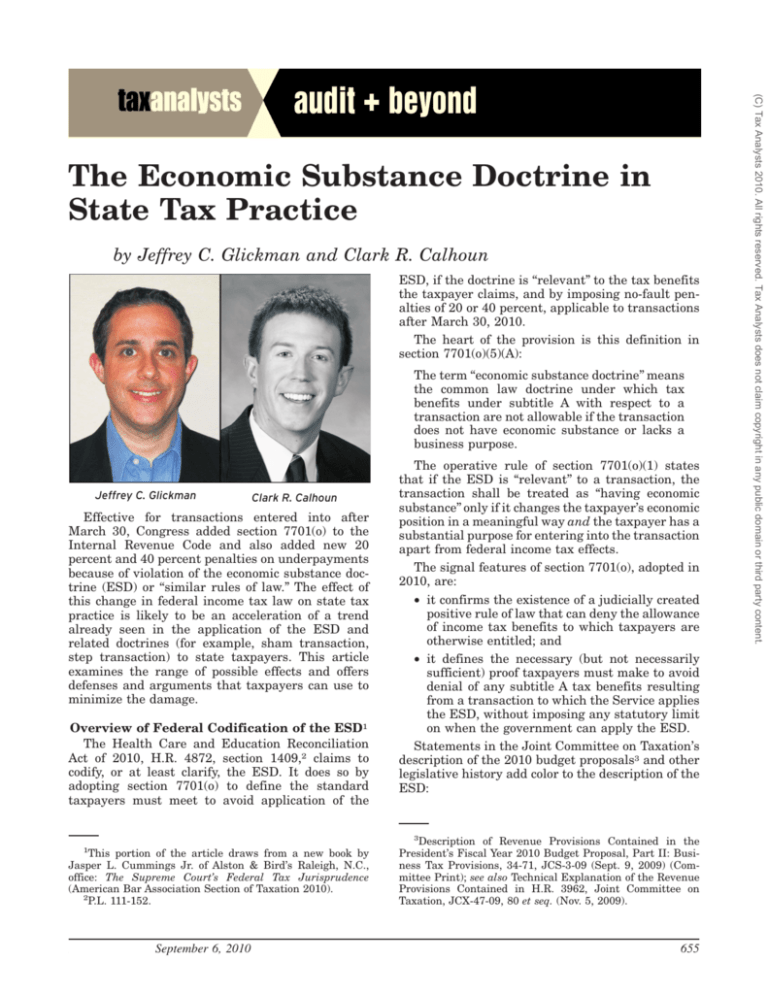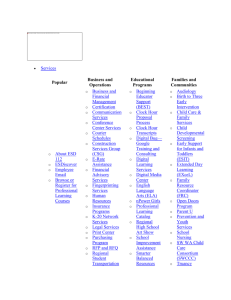
by Jeffrey C. Glickman and Clark R. Calhoun
ESD, if the doctrine is ‘‘relevant’’ to the tax benefits
the taxpayer claims, and by imposing no-fault penalties of 20 or 40 percent, applicable to transactions
after March 30, 2010.
The heart of the provision is this definition in
section 7701(o)(5)(A):
The term ‘‘economic substance doctrine’’ means
the common law doctrine under which tax
benefits under subtitle A with respect to a
transaction are not allowable if the transaction
does not have economic substance or lacks a
business purpose.
Jeffrey C. Glickman
Clark R. Calhoun
Effective for transactions entered into after
March 30, Congress added section 7701(o) to the
Internal Revenue Code and also added new 20
percent and 40 percent penalties on underpayments
because of violation of the economic substance doctrine (ESD) or ‘‘similar rules of law.’’ The effect of
this change in federal income tax law on state tax
practice is likely to be an acceleration of a trend
already seen in the application of the ESD and
related doctrines (for example, sham transaction,
step transaction) to state taxpayers. This article
examines the range of possible effects and offers
defenses and arguments that taxpayers can use to
minimize the damage.
Overview of Federal Codification of the ESD1
The Health Care and Education Reconciliation
Act of 2010, H.R. 4872, section 1409,2 claims to
codify, or at least clarify, the ESD. It does so by
adopting section 7701(o) to define the standard
taxpayers must meet to avoid application of the
1
This portion of the article draws from a new book by
Jasper L. Cummings Jr. of Alston & Bird’s Raleigh, N.C.,
office: The Supreme Court’s Federal Tax Jurisprudence
(American Bar Association Section of Taxation 2010).
2
P.L. 111-152.
State Tax Notes, September 6, 2010
The operative rule of section 7701(o)(1) states
that if the ESD is ‘‘relevant’’ to a transaction, the
transaction shall be treated as ‘‘having economic
substance’’ only if it changes the taxpayer’s economic
position in a meaningful way and the taxpayer has a
substantial purpose for entering into the transaction
apart from federal income tax effects.
The signal features of section 7701(o), adopted in
2010, are:
• it confirms the existence of a judicially created
positive rule of law that can deny the allowance
of income tax benefits to which taxpayers are
otherwise entitled; and
• it defines the necessary (but not necessarily
sufficient) proof taxpayers must make to avoid
denial of any subtitle A tax benefits resulting
from a transaction to which the Service applies
the ESD, without imposing any statutory limit
on when the government can apply the ESD.
Statements in the Joint Committee on Taxation’s
description of the 2010 budget proposals3 and other
legislative history add color to the description of the
ESD:
3
Description of Revenue Provisions Contained in the
President’s Fiscal Year 2010 Budget Proposal, Part II: Business Tax Provisions, 34-71, JCS-3-09 (Sept. 9, 2009) (Committee Print); see also Technical Explanation of the Revenue
Provisions Contained in H.R. 3962, Joint Committee on
Taxation, JCX-47-09, 80 et seq. (Nov. 5, 2009).
655
(C) Tax Analysts 2010. All rights reserved. Tax Analysts does not claim copyright in any public domain or third party content.
The Economic Substance Doctrine in
State Tax Practice
Audit + Beyond
doctrines developed at the federal level, such
as the step transaction doctrine.6
The secretary added that it had previously held
that ‘‘all federal statutes, doctrines, and case law
relevant to determining federal taxable income are
available for use by the state.’’7
The starting position for taxpayers
in state cases should be that the
economic substance doctrine is
not relevant beyond the issues
that can arise under the IRC.
Thus, the codification of the ESD in federal law
will likely have little impact on state tax decisions
that turn directly on determinations of federal taxable income. State tax departments have been applying the ESD (and other equitable doctrines applied by the IRS and blessed by the federal courts)
for years, in reliance on decisions by the U.S. Supreme Court and other federal authorities, and
there is little reason to believe that states have held
back from applying the doctrines to federal tax
concepts simply because the ESD had not been
memorialized in the U.S. Code.8
Extension to State-Specific
Income Tax Issues
Included in this authority to determine federal
taxable income is the power to use equitable
Several important issues in state tax contexts
simply do not have federal analogs. Most notably,
those include allocation and apportionment issues
for multistate taxpayers, including the subcategory
of business versus nonbusiness income, and the U.S.
Constitution’s commerce clause nexus issues. The
threshold issue at the state level is the relevance of
the ESD to the state tax issue, because section
7701(o)(1) states that the ESD must be relevant to a
transaction before the doctrine should be applied.
Therefore, the starting position for taxpayers in
state cases should be that the ESD is not relevant
beyond the issues that can arise under the IRC.
4
For a more in-depth exploration of states’ application of
the economic substance doctrine (ESD) and related doctrines,
see Jeffrey C. Glickman and Clark R. Calhoun, ‘‘The ‘States’
of the Federal Common Law Tax Doctrines,’’ 61 The Tax
Lawyer 1181 (2008).
5
See, e.g., Syms Corp. v. Comm’r, 765 N.E.2d 758 (Mass.
2002), and Sherwin-Williams Co. v. Comm’r, 778 N.E.2d 504
(Mass. 2002) (applying Mass. Gen. Laws ch. 62C, section 3A
(2003) (granting authority to the Massachusetts commissioner to disallow asserted tax consequences of a transaction
‘‘by asserting . . . the sham transaction doctrine or any other
related tax doctrine’’)). For the decision in Syms, see Doc
2002-8734 or 2002 STT 71-23; for the decision in SherwinWilliams, see Doc 2002-24629 or 2002 STT 213-20.
6
In re Proposed Assessment of Corp. Income Tax for Tax
Years Ended Dec. 31, 1989 and 1990 by the Sec’y of Revenue of
N.C., No. 95-144, 1997 N.C. Tax LEXIS 48 (N.C. Dep’t of
Revenue Aug. 26, 1997).
7
Id. at *34.
8
See, e.g., Syms, 765 N.E.2d at 762 n.7 (citing federal cases
applying the economic substance doctrine); McMillin-BCED/
Miramar Ranch North v. County of San Diego, 37 Cal.Rptr.2d
472 (Cal. App. 4th Dist. 1995) (citing federal cases applying
the step transaction doctrine); SLI International Corp. v.
Crystal, No. CV93 0519789S, 1994 WL 450466 (Conn. Super.
Ct. Aug. 12, 1994), rev’d on other grounds, 671 A.2d 813
(Conn. 1996); Baisch v. Dep’t of Revenue, 850 P.2d 1109 (Ore.
1993).
The Direct Piggyback Effect
Before the codification of the ESD, many state
income tax auditors were applying the ESD as it was
already being applied by the federal courts to adjust
federal taxable income — generally based on a state
law provision (or in some cases, simply a state law
theory) authorizing the application of the federal
doctrines in state tax contexts.5 For example, in
upholding an assessment of North Carolina state
income taxes, the secretary said:
656
State Tax Notes, September 6, 2010
(C) Tax Analysts 2010. All rights reserved. Tax Analysts does not claim copyright in any public domain or third party content.
The Economic Substance Doctrine: A taxpayer
whose facts (as properly determined by use of
all applicable substance over form methods of
fact finding) otherwise satisfy the legal requirements (as properly interpreted) for a tax
benefit (whether the benefit is generally
viewed as a benefit to taxpayers, or is beneficial to the particular taxpayer only because of
the particular facts of the case), shall be denied
that tax benefit if (1) the Service denies the tax
benefits in whole or part by asserting application of the ESD to the taxpayer’s transaction
that facilitated the tax benefits, (2) the taxpayer was motivated to carry out that transaction by a purpose to obtain that tax benefit, (3)
the benefit was not intended by Congress, and
(4) the taxpayer fails to prove satisfaction of
the two prong codified economic substance doctrine test.
Interestingly, although the statute includes a
statement that the ESD should be applied as if the
codification had never been enacted, aspects of the
codification (for example, the statute’s requirement
that a challenged tax benefit have economic substance and a business purpose) suggest that the
codification of the ESD is intended to have a broader
effect by standardizing what had been inconsistent
requirements from circuit to circuit in applying the
doctrine. The extent to which the (now codified) ESD
will be applied by state tax administrators is the
subject of the remainder of this article.4
Audit + Beyond
Extension to Tax Issues Other Than
Income Taxes
The codified ESD applies only to the federal
income tax and has an exception for ‘‘personal transactions of individuals’’ not connected to any trade or
business.11 Therefore, the ESD codification does not
apply at the federal level, for example, to the estate
and gift taxes, nor does it apply to employment or
excise taxes.
State governments, of course, rely on an even
wider array of non-income-based taxes than the
federal government. Examples include property
taxes, license taxes, sales and use taxes, and real
estate transfer taxes. Given that the codified ESD
applies only to income taxes, the codification of the
ESD arguably should have no relevance to a state’s
non-income-based taxes; moreover, the federal limitation on the application of the codified ESD to
income taxes gives taxpayers an argument that
states should not be able to apply the doctrine
outside the income tax context.
However, it would be foolish to assume that states
could not take a more aggressive position in apply-
9
Dep’t of Revenue v. Puffnstuff, Inc., No. IT 01-18 (Ill. Dep’t
of Revenue Office of Admin. Hearings, Oct. 5, 2001), available
at http://www.revenue.state.il.us/legalinformation/hearings/
it/it01-18.pdf (state administrative judge refused to allow
application of step transaction doctrine to force recognition of
nonbusiness income because state should apply a federal
doctrine only in a ‘‘comparable context’’ to the way the
doctrine is applied at the federal level). Note that ‘‘Puffnstuff,’’ as well as other names in the decision, are aliases.
10
In re Petitioner, No. 15696, 2002 WL 34135092 (Idaho
State Tax Comm’n Sept. 16, 2002); see also TD Banknorth,
N.A. v. Dep’t of Taxes, 967 A. 2nd 1148 (Vt. Sept. 19, 2008)
(upholding application of ESD regarding the state’s bank
franchise tax); Wal-Mart Stores East, Inc. v. Hinton, Sec’y of
Revenue, No. 06-CVS-3928, slip. op. at 23 (N.C. Super. Ct.
Dec. 31, 2007) (applying the ESD to a captive real estate
investment trust structure and allowing the secretary to
require combined returns). For the decision in Banknorth, see
Doc 2008-20199 or 2008 STT 185-22.
11
26 U.S.C. section 7701(o)(5)(B).
State Tax Notes, September 6, 2010
ing the ESD outside the income tax context. Although states have historically been much less likely
to apply the doctrines to other taxes, there are
precedents for states doing so. For example, in In re
TJX Cos., TJX Companies Inc. contracted with
Ames Department Stores Inc. to sell to Ames a
division of TJX referred to as the Zayre Division.12
The parties agreed to structure that transaction for
federal income tax purposes so that each of them
could make an IRC section 338(h)(10) election. To
effectuate that structure, TJX made capital contributions of Zayre assets to four wholly owned subsidiaries, then transferred the stock in those subsidiaries to Ames for cash. In accordance with the
section 338(h)(10) election, the subsidiaries were
treated as if they had sold all of their assets as of the
date of the transaction.13
The federal limitation on the
application of the codified ESD to
income taxes gives taxpayers an
argument that states should not be
able to apply the doctrine outside
the income tax context.
Following that transaction, the New York Division of Taxation assessed the taxpayer for unpaid
sales tax, arguing that under the ESD the transactions should be treated in substance as a single
transaction giving rise to a taxable sale of assets.
The New York Division of Tax Appeals rejected that
position, stating that the structure of the transaction was designed to take advantage of a specific
federal tax provision and therefore had a valid
non-sales-tax-avoidance purpose.14 Thus, although
the New York administrative law judge rejected the
state’s attempt to apply the ESD in that sales tax
context, the case shows that state departments of
revenue have been willing to apply the ESD and
other doctrines outside the income tax arena. Cases
from Illinois, New York, and Tennessee demonstrate
12
No. 812048, 1995 N.Y. Tax LEXIS 590 (N.Y. Div. of Tax
App. Nov. 9, 1995), aff’d on other grounds, No. 812048 (N.Y.
Tax. App. Trib. Feb. 13, 1997).
13
Id. at *16-17.
14
Id. at *22. After considering the state’s argument regarding the ESD, the administrative law judge considered the
state’s additional argument that the step transaction doctrine
should be applied. The ALJ concluded that the step transaction analysis was not appropriate to determine whether sales
tax should be due. Id. at *27. However — as is clear from Kelly
I, cited infra at note 15 — the state’s conclusion in TJX should
not be taken as a rejection of the step transaction doctrine in
all non-income-tax contexts under New York law.
657
(C) Tax Analysts 2010. All rights reserved. Tax Analysts does not claim copyright in any public domain or third party content.
However, state revenue departments have asserted and likely will continue to assert the opposite.
Indeed, although at least one state has refused to
extend the ESD to a state income tax issue with no
federal analog,9 several states have not hesitated to
apply the ESD and related doctrines to state tax
issues, with or without a comparable federal income
tax concept. For example, the Idaho State Tax Commission upheld the application of the step transaction doctrine to an adjustment of a taxpayer’s apportionment factors.10 Thus, that an income tax issue
has no comparable federal concept appears unlikely
to prevent a state from asserting that the ESD is
relevant to the determination of that income tax
item.
Audit + Beyond
The Proper Role of the ESD
As indicated above, the ESD is most properly
viewed as a positive rule of law that decrees that the
taxpayer loses even though it otherwise is entitled to
the tax benefit, if the taxpayer cannot carry the
burden of proof on the two prongs of the codified
ESD test. Unfortunately, many federal courts have
begun to skip directly to the ESD issue, overlooking
taxpayers’ arguments that the ESD is not relevant
to the circumstances or that the tax benefit was
intended on the taxpayer’s facts. State courts can be
expected to take the same shortcuts. Taxpayers,
particularly those that are relatively comfortable
with their facts and the law, should protest that the
ESD is designed to be a last step (and rarely applied)
because it upsets the law as written by the legislature.
Statutory Interpretation
Gregory v. Helvering16 is said to be ‘‘all things to
all men,’’17 and ‘‘one of the most protean judicial
doctrines in the tax law.’’18 The U.S. Treasury identifies it as the origin of both the substance-over-form
doctrine and the business purpose doctrine,19 and
hence the core of the tax-specific doctrines. But in
reality, Gregory was a case of statutory construction
15
See also JI Aviation, Inc. v. Ill. Dep’t of Revenue, 781
N.E.2d 469 (Ill. App. Ct. 2002) (applying substance-over-form
and step transaction doctrines to purchase of aircraft involving qualified intermediary); Hutton v. Johnson, 956 S.W.2d
484 (Tenn. 1997) (adopting step transaction doctrine to determine whether purchaser of aircraft was entitled to trade-in
credit); In re Kelly I, No. 819863, 2005 N.Y. Tax LEXIS 282
(N.Y. Div. of Tax. App. Dec. 8, 2005) (applying step transaction
doctrine to real estate transfer taxes). But see Estep v. King
County, 401 P.2d 332, 334 (Wash. 1965) (rejecting application
of step transaction doctrine to transaction involving real
estate excise tax, stating that ‘‘adoption of the rule would
write into Washington law a provision not voiced by the
legislature’’).
16
Gregory v. Helvering, 293 U.S. 465 (1935).
17
Randolph E. Paul, Studies in Federal Taxation, Third
Series, at 126 (Harvard 1940).
18
Robert Clark, ‘‘The Morphogenesis of Subchapter C: An
Essay in Statutory Evolution and Review,’’ 87 Yale L.J. 90,
122 (1977).
19
Treasury White Paper on Corporate Tax Shelters IVB1
and 2 (July 1, 1999), 1999 TNT 127-12 (July 1, 1999).
658
in which the U.S. Supreme Court construed a normal course-of-business requirement into the statutory words ‘‘in pursuance of a plan of reorganization.’’ Gregory did not create an all-purpose
requirement for ‘‘business purpose’’ for enjoyment of
all allowances and deductions, much less all tax
‘‘benefits’’ (as asserted in the ESD).20 No Supreme
Court decision says it did, although later Court
opinions recognized that the transitory corporation
Gregory’s plan used would be ignored for tax purposes (and called a sham) because it had no business
or corporate purpose, under the later announced
rule of Moline Properties.21
Therefore, when the codification of the ESD memorializes the requirement of a substantial non-taxavoidance purpose to qualify for a tax benefit, it
presumably is reaching back to authority like Gregory, which did something very different: It interpreted a requirement of a business purpose into a
specific code section based on some real evidence of
the plain language of the statute (there, the Court
understood that reorganization commonly meant an
actual realignment of a real business, and required
such a realignment to obtain the tax benefit).
States that have been less
aggressive in applying the
doctrines to state tax issues may
begin to assert the doctrines on a
more regular basis.
This reflection on Gregory is a long way of noting
that while it may often be contrary to a taxpayer’s
interest to direct a court to consider the legislative
intent behind a particular tax provision, in some
cases the best strategy to avoid the application of the
ESD will be to focus the court or administrator’s
attention on the meaning of the taxing statute. If the
court or administrator believes that the tax benefit
was intended (or at least that the claimed benefit is
20
Robert S. Summers, ‘‘A Critique of the Business Purpose
Doctrine,’’ 41 Ore. L. Rev. 38, 40 (1961) (identifying as one of
the least accurate formulations of the doctrine the statement
that ‘‘to reduce taxes, a taxpayer must always show that he
intended his transactions to serve a non tax purpose’’).
21
Moline Properties, Inc. v. Commissioner, 319 U.S. 436
(1943). See Miller, ‘‘Federal Courts as Makers of Income Tax
Law,’’ 6 Tax L. Rev. 151, 161 (1951) (citing Gregory as a chief
example of lower courts turning what should have been a
dummy corporation decision into a new principle of law). The
Court made this connection of Moline to Gregory in Nelson v.
Adams, USA, Inc., 529 U.S. 460, 471 (2000), and National
Carbide Corp. v. Commissioner, 336 U.S. 422 (1949). But even
in 1935 the Court called Gregory a sham transaction case.
Helvering v. Minnesota Tea Co., 296 U.S. 378, 385 (1935).
State Tax Notes, September 6, 2010
(C) Tax Analysts 2010. All rights reserved. Tax Analysts does not claim copyright in any public domain or third party content.
states’ willingness to apply the federal tax doctrines
in a variety of non-income-tax contexts.15
Therefore, based on these examples, it is apparent that states have been — and will continue to be
— willing to apply the ESD and other tax doctrines
to frustrate the anticipated state tax consequences
of a transaction. Further, as discussed above, the
codification of the ESD could embolden state tax
departments to apply the ESD and other doctrines
much more broadly than they have in the past.
Audit + Beyond
Conclusion
Thus, to a large degree, it appears that the
codification of the ESD at the federal level will not
have much of an effect on the behavior of state tax
administrators, because state tax administrators
have already been applying the ESD and related
doctrines in state tax contexts — both those involving income tax issues as well as (though less frequently) other types of taxes. However, that the
federal statute applies the ESD only to income taxes
gives taxpayers some ammunition that states’ application of the doctrine should be also limited to
income tax issues. It is questionable whether that
State Tax Notes, September 6, 2010
argument will succeed. What is clear is that the
codification of the ESD at the federal level is likely
to further embolden those states already applying
the doctrine. It is also likely that those states that
have been less aggressive in applying the doctrines
to state tax issues will reexamine their practices and
may begin to assert the doctrines on a more regular
basis.
✰
Audit + Beyond, a column on state tax audits and the
resolution of disagreements between business taxpayers and
state revenue departments, is written by members of the
Alston & Bird LLP state and local tax group. Jeffrey C.
Glickman is a partner and Clark R. Calhoun is an associate
with the firm’s Atlanta office.
659
(C) Tax Analysts 2010. All rights reserved. Tax Analysts does not claim copyright in any public domain or third party content.
not abusive), the ESD may be deemed not relevant
and the taxpayer will not be required to satisfy its
two prongs.







